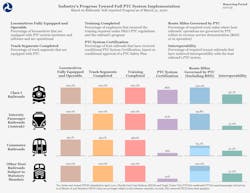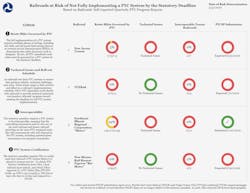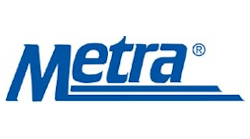Final push to PTC deadline
A 12-year journey to leverage technology to enhance safety will be able to mark the end of one chapter at the close of the year. Positive train control (PTC), the safety overlay system designed to prevent some train accidents, must be implemented by Dec. 31, 2020, as mandated originally by the Rail Safety Improvement Act of 2008.
With six months left to go before the final deadline, PTC technology remains to be activated on approximately 1,100 required route miles, which is about two percent of the total required route miles, according to the Quarter 1 2020 status update on railroads’ self-reported progress released by the Federal Railroad Administration (FRA).
FRA says while most commuter railroads’ PTC systems are in Revenue Service Demonstration (RSD) on their entire mandated networks, work remains as 63.2 percent of all commuter railroads’ cumulative required route miles were PTC-governed as of March 31. Seven rail systems – all commuter railroads – have achieved implementation including TriMet (with Portland & Western Railroad), Virginia Railway Express, North County Transit District, Sounder Commuter Rail, Metrolink, Port Authority Trans-Hudson and Northstar Commuter Rail. However, four commuter railroads – Metra, New Jersey Transit (NJ Transit), Trinity Metro’s TEXRail and Rio Metro Regional Transit District’s New Mexico Rail Runner Express have been labeled as “at risk” of being noncompliant with the final deadline by the FRA.
FRA says its four factors to evaluate the risk of noncompliance with the mandate include:
- The percentage of mandated route miles currently governed by a PTC system, including RSD;
- Any unresolved technical issue in implementing a compliant PTC system;
- The percentage of a host railroad’s tenant railroads that have achieved required interoperability; and
- A host railroad’s expected date to submit its PTC Safety Plan to FRA, necessary to obtain PTC System Certification.
Of the four at risk railroads, five percent of NJ Transit’s required route miles are PTC governed and more than 54 percent of Metra’s route miles are under PTC operation or RSD. Additionally, Metra submitted its PTC Safety Plan to the FRA in January.
FRA reports it has provided nearly $2.6 billion in grants and loans and thousands of hours of technical assistance to help railroads fully implement PTC systems and has vowed to continue working with all to-be-compliant railroads to help them meet the deadline.
A series of reports from the Government Accountability Office (GAO) has identified software issues and vendor issues as challenges for railroads as they work to implement PTC. GAO’s most recent report on PTC, released in late April, noted that some software issues had been addressed, but the challenges that remain surrounding software and vendor issues have become more acute as schedules are compressed.
Regarding software issues, the GAO’s latest report, “Positive Train Control: Railroads Generally Made Progress, but Several Must Meet Compressed Schedules to Meet Implementation Date” says:
One commuter railroad on the Northeast Corridor told us that getting a stable and effective version of software has been a major challenge. Specifically, it took longer than anticipated for the railroad to receive software with no critical defects, such as being able to recognize a stop message for a speed restriction, which contributed to a delay of at least 3 months in the railroad entering RSD. Another commuter railroad noted that it has delayed its implementation schedule to give the vendor more time to work through issues.
The GAO report also notes the challenges above are critical as it relates to railroads achieving interoperability of their PTC systems.
The Q1 2020 progress report published by the FRA says that interoperability has been achieved in 48.5 percent of the 229 applicable, host-tenant railroad relationships as of March 31, 2020, which is a 10-percent increase since the fourth quarter of 2019.
The Commuter Rail Coalition (CRC), an advocacy association whose membership is comprised of commuter railroads, suppliers and other stakeholders, says its members have found testing new software and interoperability testing with multiple partner railroads to be time consuming elements of implementation. One CRC member railroad reports it is already on its 80th software revision, while another mentioned interoperability within its territory where it connects to the Northeast Corridor as being a challenge.
Metra, which serves the Chicago area, must have its PTC system interoperable with 12 other railroads, which is the most out of all commuter railroads required to install the technology. Michael Gillis, director of communications, says progress to reach interoperability has been going well. Metra will achieve interoperability with eight of the required 12 railroads by the end of July and the final four railroads are scheduled to be interoperable by the end of the third quarter of 2020.
“It has been a lot of work but there has been a great deal of coordination and cooperation and we have made great progress,” said Gillis.
He explains the issues Metra experienced with the delivery schedules of its supplier, Wabtec, were similar to other railroads, but the situation has improved.
Reed Lanham, deputy chief operating officer of Rail at Trinity Metro, which is implementing PTC on its TEXRail system, says the system has experienced nearly all of the reported challenges associated with PTC, but cites quality communication with helping the project progress through these situations.
“In the beginning, we had issues with vendor availability because of a lack of competitive options. We have had ongoing software issues, but have been able to work with Wabtec on fixing bugs and updating software. We have not encountered any supply chain issues to this point. Workforce challenges have arisen because there is more work than people with the necessary expertise. We work with a professional team who are skilled at what they do. Individuals sometimes have more than one role, which can cause delays. Our current team has been essential in keeping the project on track,” explained Lanham. “Throughout the TEXRail project, we have overcome challenges by staying in constant communication. We meet frequently and have honest discussions about what can be done.”
KellyAnne Gallagher, executive director of CRC, notes the certification of PTC Safety Plans railroads are required to submit to FRA as part of the implementation process could hold another challenge.
“The FRA has been sending letters to commuters in response to their PTC Safety Plans stating the review process may exceed the statutory 180 days. Commuters that are planning on submitting their Safety Plans in June 2020 may see that Safety Plan Approval and System Certification will not be received until 2021,” said Gallagher.
The mandate requires FRA to certify each host railroad’s PTC system before it is placed in revenue service. Railroads must submit a PTC Safety Plan to FRA for approval before certification can be obtained. Once submitted, FRA has at least 180 days to review and respond to the safety plan.
According to the GAO report published in April, FRA can consider a railroad with conditional certification of its PTC safety plan fully implemented “as long as the conditions do not relate to noncompliance with the core functionality required for a PTC system by statute and the FRA-certified PTC system is interoperable and governing operations on all PTC-mandated route miles.”
Ongoing Maintenance
Commuter railroads are expressing concern about what happens after the Dec. 31, 2020, full implementation deadline, but that concern surrounds the ongoing costs of PTC systems. For example, in its FY21-FY27 Budget and Capital Plan, Rio Metro says the estimated $3.4-million annual maintenance cost of PTC will hinder its ongoing ability to undertake other capital projects.
CRC explains commuter railroads are receiving bids in the range of five to 10 percent of their annual operating budgets for ongoing operations and maintenance of the systems and this is after the commuter railroads have spent an estimated $4 billion to install and implement the technology.
“This is not an insignificant amount and is compounded by the cost of upgrades that will be required to keep PTC systems state-of-the-art and interoperable with host and tenant railroads,” said Gallagher.
CRC has asked for assurance from Congress that the ongoing expense to replace normal components of PTC systems, as well as the costs associated with continuous updates and modifications, be allowed under appropriate grant programs.
“It is important that Congress clarify the law and regulations to ensure PTC ongoing annual capital replacement costs for components and software, and the associated costs of installing such systems, are an eligible reimbursable expense under the federal formula and discretionary grant programs,” explained Jim Derwinski, CRC chair and CEO/executive director of Metra.
In addition to clarification of eligible reimbursable expenses associated with PTC, CRC made the following request of Congress prior to the COVID-19 pandemic hitting the U.S.:
- Plus-up and protect existing funding sources, such as the Consolidated Rail Infrastructure and Safety Improvements (CRISI) Program and the State of Good Repair (SOGR) Program. CRC says investing in commuter rail infrastructure makes “for sound investment of public dollars” when the useful life of the infrastructure and regional economic benefits are weighed against the higher initial costs.
- Convert the CRISI and SOGR discretionary programs to formula programs. CRC explains this would give public agencies a predictable funding stream from year-to-year and allow railroads to budget and make judicious use of public funds.
- Establish a commuter rail title to isolate and protect funds specifically intended for commuter rail systems. CRC says current formula funds (Sections 5307 and 5309) for all transit systems should provide a break-out portion of funds for commuter rail capital needs.
Impact of COVID-19
CRC reports that as COVID-19 was sweeping through Asia in February, some railroads were alerted to possible interruptions in component supply chains, sending railroads scrambling to identify alternate sources as backup.
“When COVID took hold in the U.S., railroads sought the best guidance on practices that would keep personnel safe. As researchers learn more about the virus’ transmission, railroads have modified their procedures for physical distancing and isolating exposed personnel, both of which have necessarily slowed progress on PTC,” explained Gallagher.
She notes that some vendor travel has been suspended, postponing planned testing activities and the full impacts of that have not been fully determined due to restrictions still in place for several regions.
One CRC member received a force majeure letter from its system integrator, while another received a letter from a contractor stating that they were suspending work because they could not social distance or acquire the necessary PPE and gave notice that they would be claiming delay damages. CRC says in both reported cases, the agencies are pushing for workable alternatives that won’t compromise personnel safety or delay PTC implementation.
Another CRC member said maintaining the same project pace, while maintaining compliance with federal and state health recommendations, meant it had to be innovative and flexible with its workforce and contractors who were performing PTC-related work and testing.
Lanham explains because there are so few representatives working on the TEXRail PTC project, it has been possible to maintain a consistent working relationship during the COVID-19 pandemic.
“The primary impact was waiting for restrictions to be lifted to continue work on trains. We were able to get everything installed to proceed with Revenue Service Demonstration,” said Lanham.
On the upside, many agencies are taking advantage of reduced traffic to run more PTC-related tests and one CRC member railroad reports the reduction in scheduled service produced opportunities that allowed more time on the wayside functions and on the equipment in its maintenance facilities.
Metra had to increase service on its Metra Electric line to perform the needed work to implement PTC. The Metra Electric Line had been carrying six percent of its normal riders during COVID-19 and service levels had to be increased to 74 percent of normal levels.
In a press release about the service change, Metra explained running the fuller schedule would enable the railroad to carry out all the steps needed to complete PTC implementation on the line, including testing all the equipment under normal operating conditions, troubleshooting any issues and training engineers and other personnel.
“What the world is experiencing is without modern precedent; COVID-19 is exacting a toll that grows by the day. Providing essential service and keeping essential personnel safe is the top priority for every commuter railroad,” said Gallagher. “That includes staying abreast of the most effective sanitation practices as well as safely implementing PTC.”
CRC created a forum for commuter railroads to share best practices (and non-traditional sources for PPE). Gallagher vows the association will continue to sound the alarm when COVID-related threats appear that could derail PTC for any agency that is working diligently to meet the mandate.
“From COVID-19’s direct impact on a commuter rail’s workforce, to travel bans isolating contractors, to supply chain interruptions and, before that, contractors’ missed performance targets, it is our duty to inform Congress and the FRA of the outside forces impacting commuter railroads’ efforts to meet the mandate,” said Gallagher.
Bottom Line: Will They Make It?
Confidence levels of meeting the Dec. 31, 2020, deadline are high among many of the commuter railroads labeled at-risk by the FRA.
Rio Metro’s FY21-FY27 Budget and Capital Plan includes language stating the system will meet the final December deadline and NJ Transit President and CEO Kevin Corbett expressed his confidence back in February that the railroad would meet the deadline.
“We are very confident we will finish on time,” said Metra’s Gillis. “We have basically completed work on all but two lines and we expect to have all trains running with PTC on those two lines in the fourth quarter this of year, before the deadline.”
When asked if contingency plans had been discussed at Metra should the deadline be missed, Gillis’ response was “no.”
Trinity Metro’s Lanham says there has not been contingency plans discussed for the TEXRail system, either.
“We are planning to submit our safety plan in June and do not anticipate anything that would put us in jeopardy of missing the deadline,” said Lantham. “We are very confident that we will get PTC implemented within the framework, as we have completed all field testing and are currently successfully undergoing Revenue Service Demonstration.”

Mischa Wanek-Libman | Group Editorial Director
Mischa Wanek-Libman is director of communications with Transdev North America. She has more than 20 years of experience working in the transportation industry covering construction projects, engineering challenges, transit and rail operations and best practices.
Wanek-Libman has held top editorial positions at freight rail and public transportation business-to-business publications including as editor-in-chief and editorial director of Mass Transit from 2018-2024. She has been recognized for editorial excellence through her individual work, as well as for collaborative content.
She is an active member of the American Public Transportation Association's Marketing and Communications Committee and served 14 years as a Board Observer on the National Railroad Construction and Maintenance Association (NRC) Board of Directors.
She is a graduate of Drake University in Des Moines, Iowa, where she earned a Bachelor of Arts degree in Journalism and Mass Communication.








